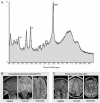Metabolic changes in concussed American football players during the acute and chronic post-injury phases
- PMID: 21861906
- PMCID: PMC3176163
- DOI: 10.1186/1471-2377-11-105
Metabolic changes in concussed American football players during the acute and chronic post-injury phases
Abstract
Background: Despite negative neuroimaging findings many athletes display neurophysiological alterations and post-concussion symptoms that may be attributable to neurometabolic alterations.
Methods: The present study investigated the effects of sports concussion on brain metabolism using 1H-MR Spectroscopy by comparing a group of 10 non-concussed athletes with a group of 10 concussed athletes of the same age (mean: 22.5 years) and education (mean: 16 years) within both the acute and chronic post-injury phases. All athletes were scanned 1-6 days post-concussion and again 6-months later in a 3T Siemens MRI.
Results: Concussed athletes demonstrated neurometabolic impairment in prefrontal and motor (M1) cortices in the acute phase where NAA:Cr levels remained depressed relative to controls. There was some recovery observed in the chronic phase where Glu:Cr levels returned to those of control athletes; however, there was a pathological increase of m-I:Cr levels in M1 that was only present in the chronic phase.
Conclusions: These results confirm cortical neurometabolic changes in the acute post-concussion phase as well as recovery and continued metabolic abnormalities in the chronic phase. The results indicate that complex pathophysiological processes differ depending on the post-injury phase and the neurometabolite in question.
Figures



Similar articles
-
Neurometabolic changes in the acute phase after sports concussions correlate with symptom severity.J Neurotrauma. 2010 Jan;27(1):65-76. doi: 10.1089/neu.2009.0962. J Neurotrauma. 2010. PMID: 19761385
-
A follow-up study of neurometabolic alterations in female concussed athletes.J Neurotrauma. 2014 Feb 15;31(4):339-45. doi: 10.1089/neu.2013.3083. Epub 2013 Dec 6. J Neurotrauma. 2014. PMID: 24053210
-
Temporal window of metabolic brain vulnerability to concussion: a pilot 1H-magnetic resonance spectroscopic study in concussed athletes--part III.Neurosurgery. 2008 Jun;62(6):1286-95; discussion 1295-6. doi: 10.1227/01.neu.0000333300.34189.74. Neurosurgery. 2008. PMID: 18824995 Clinical Trial.
-
Athletes' age, sex, and years of education moderate the acute neuropsychological impact of sports-related concussion: a meta-analysis.J Int Neuropsychol Soc. 2014 Jan;20(1):64-80. doi: 10.1017/S1355617712001464. Epub 2013 Feb 4. J Int Neuropsychol Soc. 2014. PMID: 23375058 Review.
-
Neurometabolic, electrophysiological, and imaging abnormalities.Prog Neurol Surg. 2014;28:75-85. doi: 10.1159/000358766. Epub 2014 Jun 6. Prog Neurol Surg. 2014. PMID: 24923394 Review.
Cited by
-
The effects of early exercise in traumatic brain-injured rats with changes in motor ability, brain tissue, and biomarkers.BMB Rep. 2022 Oct;55(10):512-517. doi: 10.5483/BMBRep.2022.55.10.097. BMB Rep. 2022. PMID: 36104258 Free PMC article.
-
Lower Extremity Stiffness Changes after Concussion in Collegiate Football Players.Med Sci Sports Exerc. 2017 Jan;49(1):167-172. doi: 10.1249/MSS.0000000000001067. Med Sci Sports Exerc. 2017. PMID: 27501359 Free PMC article.
-
MR Imaging Applications in Mild Traumatic Brain Injury: An Imaging Update.Radiology. 2016 Jun;279(3):693-707. doi: 10.1148/radiol.16142535. Radiology. 2016. PMID: 27183405 Free PMC article.
-
The clinical spectrum of sport-related traumatic brain injury.Nat Rev Neurol. 2013 Apr;9(4):222-30. doi: 10.1038/nrneurol.2013.33. Epub 2013 Mar 12. Nat Rev Neurol. 2013. PMID: 23478462 Review.
-
MRSI of the medial temporal lobe at 7 T in explosive blast mild traumatic brain injury.Magn Reson Med. 2014 Apr;71(4):1358-67. doi: 10.1002/mrm.24814. Epub 2013 Aug 5. Magn Reson Med. 2014. PMID: 23918077 Free PMC article.
References
-
- Fazio VC, Lovell MR, Pardini JE, Collins MW. The relation between post concussion symptoms and neurocognitive performance in concussed athletes. NeuroRehabilitation. 2007;22:207–216. - PubMed
-
- Lovell MR, Pardini JE, Welling J, Collins MW, Bakal J, Lazar N, Roush R, Eddy WF, Becker JT. Functional brain abnormalities are related to clinical recovery and time to return-to-play in athletes. Neurosurgery. 2007;61:352–359. doi: 10.1227/01.NEU.0000279985.94168.7F. discussion 359-360. - DOI - PubMed
Publication types
MeSH terms
Grants and funding
LinkOut - more resources
Full Text Sources
Other Literature Sources
Medical

